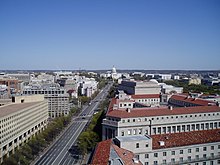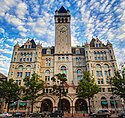Pennsylvania Avenue

Die Pennsylvania Avenue ist neben der Mall die bekannteste Straße in Washington, D.C., der Hauptstadt der Vereinigten Staaten. Ein Teil der Pennsylvania Avenue ist seit 1966 eine National Historic Site.
Das vom französischen Architekten Pierre L’Enfant geplante Straßennetz der Stadt besteht, wie in den meisten nordamerikanischen Städten, aus einem regelmäßigen, rechtwinkligen Raster. Dieses wird in Washington jedoch durch große Diagonalen überlagert. Diese Diagonalachsen sind fast ausschließlich nach Bundesstaaten der USA benannt.
Die Pennsylvania Avenue verläuft auf einer Länge von rund 11 Kilometern weitgehend geradlinig durch die Stadt. Sie beginnt im Nordwesten (Georgetown) an der Brücke über den Rock Creek, verläuft über den Washington Circus zum Weißen Haus, von dort zum Kapitol, überquert mittels der John Philipp Sousa Memorial Bridge den Anacostia River und erreicht nach wenigen Kilometern die Stadtgrenze zum Bundesstaat Maryland.
Die Straße verbindet die beiden wichtigsten Regierungsgebäude der USA, das Weiße Haus als Sitz des US-Präsidenten und das Kapitol als Sitz der beiden Parlamentskammern (Kongress der Vereinigten Staaten), die beide mitten auf der Sichtachse stehen. Zwischen diesen beiden Symbolen für die Verfassungsgewalten Exekutive und Legislative stehen entlang der Straße zahlreiche weitere Regierungsgebäude. Besonders der Abschnitt von der 6th bis zur 15th Street, wo die Straße die Nordgrenze des Federal Triangle darstellt, ist von solchen gesäumt.
Das Weiße Haus trägt die Hausnummer 1600. Die Adresse 1600 Pennsylvania Avenue wird auch als Metonym für das Weiße Haus gebraucht, ähnlich wie die Adresse Downing Street No. 10 für den Sitz des britischen Premierministers, Quai d’Orsay für das französische Außenministerium oder Wilhelmstraße für die Regierungen des Deutschen Reiches bis 1945. Das Weiße Haus steht auf dem Schnittpunkt der Achsen der Pennsylvania und der New York Avenue.
Am 30. September 1965 wurde ein Teil der Pennsylvania Avenue zur National Historic Site erklärt.[1] Am 15. Oktober 1966 wurde die Pennsylvania Avenue National Historic Site in das National Register of Historic Places aufgenommen.[2]
Die Straße war eine der ersten Durchgangsstraßen der Stadt. Viele offizielle Paraden und unzählige Protestumzüge werden jedes Jahr entlang dieser Straße abgehalten, z. B. am 24. März 2018 die nationale Hauptveranstaltung des March for Our Lives.
Nach dem Bombenanschlag auf das Murrah Federal Building in Oklahoma City im Jahr 1995 wurden Teile der Straße in der Nähe des Weißen Hauses für den Straßenverkehr gesperrt, nach den Terroranschlägen am 11. September 2001 wurde die Sperrung dauerhaft.
Sehenswürdigkeiten
Folgende Sehenswürdigkeiten und Gebäude befinden sich an der Straße:
| Name | Bild | Beschreibung |
|---|---|---|
| John Philip Sousa Bridge |  | Die John Philip Sousa Bridge, auch bekannt als Sousa Bridge und Pennsylvania Avenue Bridge, ist eine durchgehende Stahlblechträgerbrücke, die die Pennsylvania Avenue SE über den Anacostia River führt. Die Brücke ist nach dem berühmten Dirigenten und Komponisten der United States Marine Band, John Philip Sousa, benannt, der in der Nähe des nordwestlichen Endpunkts der Brücke aufwuchs. |
| Barney Circle |  | Barney Circle ist ein kleines Wohnviertel zwischen dem Westufer des Anacostia River und dem östlichen Rand des Capitol Hill im Südosten von Washington, D.C. |
| Kapitol der Vereinigten Staaten |  | Sitz des Kongresses (Senat und Repräsentantenhaus) |
| Peace Monument |  | Denkmal |
| National Gallery of Art |  | Kunstmuseum |
| John Marshall Park |  | Park, benannt nach John Marshall |
| Kanadische Botschaft |  | Botschaft von Kanada |
| Newseum | (c) David Monack, CC BY-SA 3.0 us | Museum |
| Federal Trade Commission Building |  | Sitz der Federal Trade Commission |
| National Archives Building |  | Sitz des National Archives and Records Administration |
| United States Navy Memorial |  | Gedenkstätte |
| J. Edgar Hoover FBI Building |  | Sitz des Federal Bureau of Investigation |
| Robert F. Kennedy Building |  | Sitz des Justizministerium der Vereinigten Staaten |
| 1001 Pennsylvania Avenue |  | Sitz der Carlyle Group |
| Old Post Office Pavilion | Luxushotel Trump International Hotel Washington, D.C. | |
| Ronald Reagan Building and International Trade Center |  | Sitz des United States Customs and Border Protection, der United States Agency for International Development, und der Woodrow Wilson International Center for Scholars |
| John A. Wilson Building |  | |
| Freedom Plaza |  | Platz |
| National World War I Memorial |  | Nationale Gedenkstätte zum Gedenken an die Verdienste der Angehörigen der US-Streitkräfte im Ersten Weltkrieg. |
| Treasury Building |  | Sitz des Finanzministerium der Vereinigten Staaten |
| Weißes Haus |  | Sitz des Präsidenten der Vereinigten Staaten |
| Lafayette Square |  | Park im President’s Park |
| Blair House |  | offizielle Gästehaus des US-Präsidenten |
| Renwick Gallery |  | |
| Weltbank |  | Sitz der Weltbank |
| Mexikanische Botschaft |  | Botschaft von Mexiko |
| George Washington University | Universität | |
| Internationale Finanz-Corporation |  | Sitz der Internationalen Finanz-Corporation |
| Washington Circle | Kreisverkehr | |
| Spanische Botschaft |  | Botschaft von Spanien |
| Rock Creek Park | Park | |
| Georgetown | Stadtteil |
Weblinks
Einzelnachweise
- ↑ National Park Service: The National Parks: Index 2009–2011. Innenministerium der Vereinigten Staaten, ISBN 978-0-912627-81-6, S. 36.
- ↑ Pennsylvania Avenue National Historic Site im National Register Information System. National Park Service, abgerufen am 3. August 2017.
Koordinaten: 38° 53′ 38,4″ N, 77° 1′ 26″ W
Auf dieser Seite verwendete Medien
Autor/Urheber: Tim Evanson, Lizenz: CC BY-SA 2.0
Rowhouses on the 800 block of Kentucky Avenue SE in the Barney Circle neighborhood in Washington, D.C., in the United States. The neighborhood was developed between 1919 and 1921 to accommodate a sudden influx of defense workers in during World War I. The homes are primarily two-story brick rowhouses with mansard roofs and dormers, with open-air front porches. Most of the homes are set back from the street at a uniform distance, and have a front yard. The houses tend to wide and shallow, unlike rowhouses elsewhere on Capitol Hill (which are narrow and deep). This type of rowhouse is known as a "daylight rowhouse", and was developed in the early 20th century to permit maximum daytime lighting of all rooms as a means of reducing electricity use for lighting.
(c) David Monack, CC BY-SA 3.0 us
Newseum — Pennsylvania Ave. facade and entrance, in Washington, D.C.
(c) Photograph by Mike Peel (www.mikepeel.net)., CC BY-SA 4.0
Old Post Office Building, Washington, D.C.
Autor/Urheber: Beyond My Ken, Lizenz: CC BY-SA 4.0
The Ronald Reagan Building and International Trade Center, located at 1300 Pennsylvania Avenue NW in Washington, D.C., was built from 1989 to 1998, and was designed by James Ingo Freed of Pei Cobb Freed & Partners in the neo-Classical style. It was the first federal building in Washington designed for both governmental and private sector purposes, although post-9/11 security requirements have limited the amount of public/private access anticipated by the center's designers. The organizations located in the building are dedicated to international trade and globalization. They include U.S. Customs and Border Protection, the U.S. Agency for International Development, and the Woodrow Wilson International Center for Scholars. The building hosts conferences, trade shows, cultural events, and outdoor concerts.
Autor/Urheber: APK, Lizenz: CC BY-SA 4.0
John A. Wilson Building in Washington, D.C.
Autor/Urheber: Tony Hisgett from Birmingham, UK, Lizenz: CC BY 2.0
Renwick Gallery 1
Autor/Urheber: Antony-22, Lizenz: CC BY-SA 4.0
The John Philip Sousa Bridge over the Anacostia River in Washington, DC in January 2015
Autor/Urheber: Alvesgaspar, Lizenz: CC BY-SA 4.0
Main facade of the National Gallery of Art, Washington DC
The President's Guest House in Washington, D.C.
Autor/Urheber: UpstateNYer, Lizenz: CC BY-SA 3.0
View looking southeast of Pennsylvania Avenue from the tower at the Old Post Office Pavilion in Washington, D.C.
Autor/Urheber: AgnosticPreachersKid, Lizenz: CC BY-SA 3.0
John Marshall Park in the Judiciary Square neighborhood of Washington, D.C.
Visible in the background, far right, on the terrace wall of the steps, is the bas-relief panel Urban Life (1942) by sculptor John Gregory.
Autor/Urheber: FaceMePLS from The Hague, The Netherlands, Lizenz: CC BY 2.0
1600 Pennsylvania Ave NW.
Built between 1792 and 1800 of white-painted Aquia sandstone in the late Georgian style and has been the executive residence of every U.S. President since John Adams.
Today, the White House Complex includes the Executive Residence (in which the First Family resides), the West Wing (the location of the Oval Office, Cabinet Room, and Roosevelt Room), and the East Wing (the location of the office of the First Lady and White House Social Secretary), as well as the Old Executive Office Building, which houses the executive offices of the President and Vice President.
Het Witte Huis is het werkterrein en de ambtswoning van de zittende president van de Verenigde Staten. Het gebouw is als centrum van de speciaal als hoofdstad ontworpen stad Washington D.C. gebouwd.Autor/Urheber: Shiny Things, Lizenz: CC BY 2.0
The World Bank Group headquarters building in Washington, D.C.
- Designed by Kohn Pedersen Fox.
Autor/Urheber: Die Autorenschaft wurde nicht in einer maschinell lesbaren Form angegeben. Es wird TiHa~commonswiki als Autor angenommen (basierend auf den Rechteinhaber-Angaben)., Lizenz: CC BY-SA 2.5
test
Autor/Urheber: AgnosticPreachersKid, Lizenz: CC BY-SA 3.0
The Embassy of Canada located at 501 Pennsylvania Avenue, N.W., in the Penn Quarter neighborhood of Washington, D.C.
Autor/Urheber: Martin Kraft, Lizenz: CC BY-SA 4.0
Mexikanische Botschaft, 1911 Pennsylvania Avenue N. W., Washington, D.C.
Autor/Urheber: unknown, Lizenz: CC BY-SA 3.0
Autor/Urheber: AgnosticPreachersKid, Lizenz: CC BY-SA 3.0
The International Finance Corporation headquarters, designed by Architects Michael Graves, and Vlastimil Koubek, in collaboration with Structural Engineer, Emanuel E. Necula, PE/PC, located at 2121 Pennsylvania Avenue, NW in the Foggy Bottom neighborhood of Washington, D.C.
(c) AgnosticPreachersKid at en.wikipedia, CC BY-SA 3.0
Orange tulips planted in Washington Circle, a traffic circle located at the intersection of Pennsylvania Avenue, New Hampshire Avenue, K Street, and 23rd Street, NW in the Foggy Bottom neighborhood of Washington, D.C. The equestrian statue of George Washington was sculpted by Clark Mills and dedicated in 1859.
Autor/Urheber: Sealy j, Lizenz: CC BY-SA 4.0
A view of the North entrance of the U.S. Treasury Building in Washington D.C.
Autor/Urheber: David Samuel, User:Hellodavey1902, Lizenz: CC BY-SA 3.0
Photograph of the United States National Archives Building, Washington D.C.
Title: Aerial view of LaFayette Park, located directly north of the White House on H Street between 15th and 17th Streets, N.W., Washington, D.C
Physical description: 1 photograph : digital, TIFF file, color.
Notes: Gift; Carol M. Highsmith; 2009; (DLC/PP-2009:083).; Photographed as part of an assignment for the General Services Administration.; Title, date, and subject note provided by the photographer.; Lafayette Square is a seven-acre public park. The Square and the surrounding structures were designated a National Historic Landmark District in 1970. Originally planned as part of the pleasure grounds surrounding the Executive Mansion. The park has been used as a race track, a graveyard, a zoo, a slave market, an encampment for soldiers during the war of 1812, and many political protests and celebrations. In 1824 the square was officially named in honor of General Lafayette of France.; Credit line: Photographs in the Carol M. Highsmith Archive, Library of Congress, Prints and Photographs Division.; Forms part of the Carol M. Highsmith Archive.Autor/Urheber: AgnosticPreachersKid, Lizenz: CC BY-SA 3.0
The United States Navy Memorial, located on the 700–800 blocks of Pennsylvania Avenue, N.W., in the Penn Quarter neighborhood of Washington, D.C.
Autor/Urheber: Der ursprünglich hochladende Benutzer war SimonP in der Wikipedia auf Englisch, Lizenz: CC BY-SA 3.0
Embassy of Spain in Washington, D.C.
The Apex Building, headquarters of the Federal Trade Commission, on Constitution Avenue and 7th Streets in Washington, D.C.. The building was designed by Edward H. Bennett under the purview of Secretary of the Treasury Andrew W. Mellon, and was completed in 1938 at a cost of $125 million.
Autor/Urheber: Brunswyk, Lizenz: CC BY-SA 3.0
J. Edgar Hoover Building (FBI)
Title: The Peace Monument located in Peace Circle on the grounds of the U.S. Capitol, First St. and Pennsylvania Ave., Washington, D.C
Physical description: 1 photograph : digital, TIFF file, color.
Notes: Gift; George F. Landegger; 2010; (DLC/PP-2010:176).; Title, date, subject note, and keywords provided by the photographer.; Credit line: The George F. Landegger Collection of District of Columbia Photographs in Carol M. Highsmith's America, Library of Congress, Prints and Photographs Division.; The Peace Monument, also known as the Naval Monument or Civil War Sailor's Monument, is a 44 foot high white marble memorial erected in 1877-1878, to commemorate the naval deaths at sea during the American Civil War.; Forms part of the George F. Landegger Collection of District of Columbia Photographs in Carol M. Highsmith's America Project in the Carol M. Highsmith Archive.Autor/Urheber: APK, Lizenz: CC BY 4.0
National World War I Memorial, formerly known as Pershing Park, in Washington, D.C.
































